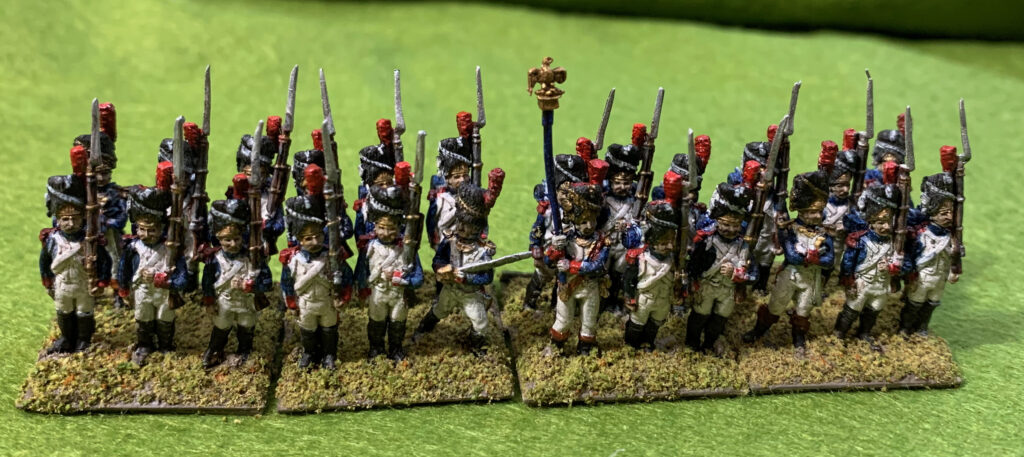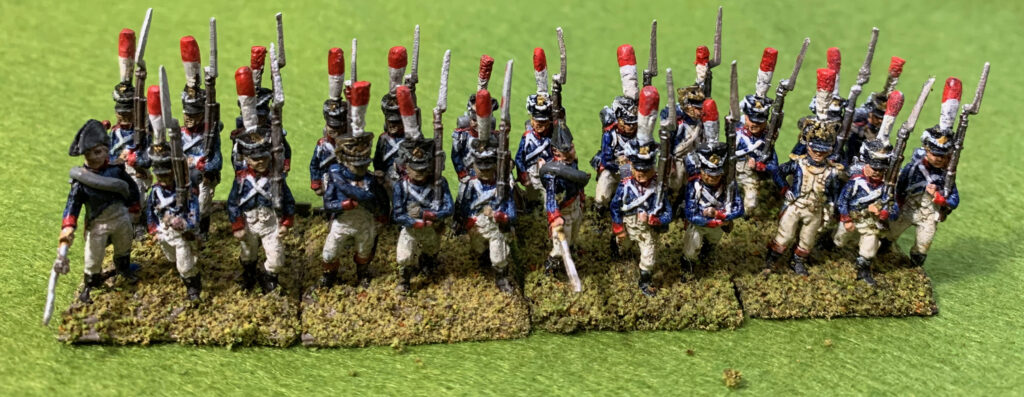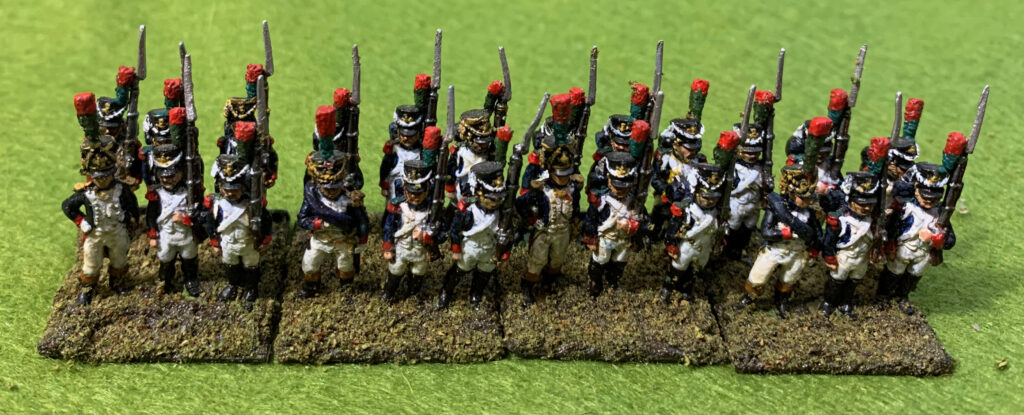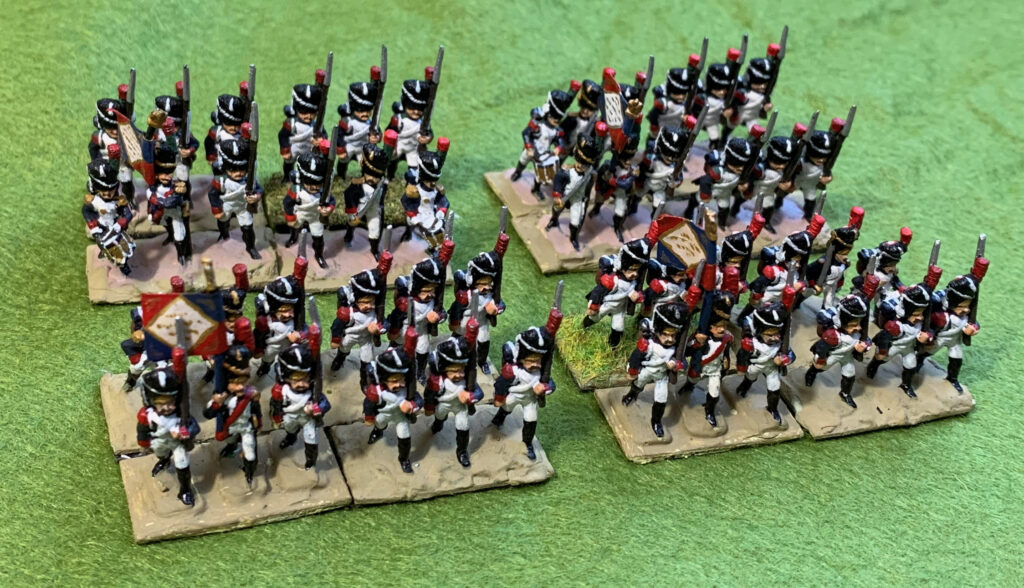
Back to the Napoleonic lead mountain for my next project. This is French Guard infantry circa 1809, using AB 18mm figures. In my original Minifigs army of the 1980s I had a couple of units of French Old Guard. I actually still have them – the only ones left from my French army. As befits Guard troops, I had taken more trouble to paint them than any of my other figures and they look quite smart. But not long after this I decided to upgrade the army with bigger, better figures from other manufacturers. The Guard was included in my schemes. My plan was to have 24 figures representing six types in 1809, with Grenadiers and Chasseurs from each of the Old, Middle and Young Guard. In those days I mounted them in strips of 3 figures, with four to a battalion, so this meant two units of each.
I started the upgrade with the Middle Guard, using AB figures for the Fusilier-Grenadiers and Fusilier-Chasseurs. After this I wanted to do the Young Guard with Tirailleur units. But at that time AB didn’t produce figures for them. Instead I used French light infantry figures, with Middle Guard figures for the drummers, half the officers, and NCOs – how realistic this is I don’t know. For the Tirailleur-Grenadiers this required the addition of a plume on the light infantry figures. I painted up 12 each of the Grenadiers and Chasseurs, leaving the same number unpainted, though converted. That’s where it stayed for more than 20 years, as I was distracted by other things. These 12 bases (in my new format of 6-figure bases) have seen a lot of active service, especially the Young Guard, but with only my diminutive Minifigs to represent the Old Guard, it was a bit of an embarrassment, though the Fusilier units often stood in for them. In 2019 I at last bought the AB Old Guard figures required to complete the project.
What I did this time was four bases each of the Old Guard units, and two each of Young Guard, to complete the original project. Here are the Old Guard:


These are represented in parade uniform with black winter gaiters. This is the most popular depiction amongst artists, whom we wargamers tend to follow. I think they would only rarely have looked like this on the battlefield though. In 1809 (presumably after the campaign that year) the Old Guard adopted a service uniform for the field, featuring a surtout and blue trousers, or greatcoats. Before that I expect they wore white gaiters in summer (which I don’t like as it makes them look like ballet dancers), or greatcoats in winter.
I wanted the figures to be reasonably compatible with the original ones., though my painting style has changed quite a bit in the intervening period. I undercoated with white gesso, applied with an airbrush for the first time (I mounted them on strips of card, one for each base). This worked pretty well. Coverage wasn’t perfect, but better than using an aerosol, and without the clouds of droplets. The blue for the uniform came from a mix of Indantherene Blue and Payne’s Grey, as per the originals. My usual go-to dark blue is now Prussian Blue Hue, but back in the day I used Indantherene, which is a bit darker and a touch redder. It’s actually a pretty decent starting point to represent indigo dye, and I bought myself a new tube when the original one died out (it wasn’t one of the everlasting Liquitex paints). For dark brown I used Burnt Umber rather than the more usual Raw Umber; I used this mixed with the blue to get the black. I didn’t mix a little white with everything, as is my current habit, as I didn’t for the old figures – but the primer was a brilliant white, so this helped to lighten things a bit. The rest of the paint choices were unremarkable; the white was Titanium White with a little Burnt Umber; I cooled down the Cadmium Red Hue with a little green; the green was Sap Green with some added blue and a touch of white. I suffered a bit of a disaster after the first painting session, when I left the top off my Stay-Wet palette, letting all the mixes dry out. When I renewed the water I put too much in, which meant that my subsequent paints were all too thin, making things much harder to manage than they should have been. I didn’t attempt quite as much detail as the old figures – no gold buttons for instance. But I did have a go at the moustaches and the gold rings on the muskets.
The AB figures were lovely, making the task much easier and more satisfying than my my Old Glory French Chasseurs. Still there were some gaps. AB don’t attempt the grenade patch on the Grenadiers’ caps, and the cuff flaps (which should be white) were vague and hard to find. I gave up trying to do blob for the former, as it just looked a mess; with the cuff-flaps I did attempt the first few and then gave up. Once the paint was on, I decided to do a wash, as I had for the original figures. I didn’t want to use the usual W+N Peat Brown ink, as this looks awful on white. I experimented with Daler-Rowney Antelope Brown ink (heavily diluted with water), but this stained the white with yellow, so I added quite a bit of black to it. I put it on quite generously; at first application it was too heavy on the white on the front of the figure, but I was able to brush most of this off (it tended to gather in the crotch, which needed attention). I was quite astonished by how much it improved the look of the figures, bringing out the beautiful detail in the mouldings. A wash produces a sharper contrast than the more subtle glaze method, like Quickshade, that I have used a lot. It lines the details more crisply – but it does this without being too cartoonish. Perhaps for 28mm figures the glaze technique works better than a wash, but this is the way to go for my 18mms, with my skill level anyway. I decided not to highlight or varnish.
Meet the Young Guard:


The two bases on the viewer’s left are the new ones, the ones on the right are the originals. The new ones are distinctly duller and darker, and the wash used on the originals was plainly a bit browner. But the two should work well enough together on the table. In particular the green on the Chasseurs’ pompoms and plumes doesn’t zing in my new figures (I have the same issue with the Old Guard Chasseurs); this is partly because the paint had become over thinned, and was mainly painted over black, overlapping from the headgear.
A word about the bases. I had rebased the old figures last winter. I used my usual method, with a gunk of acrylic gel with sand and Raw Umber paint to set the figures in. On top of that I put mix of mainly Woodland Scenic flock. I now feel that this combination is a bit dark, and the a lighter colour would show the figures off better. This time I put a bit a bit white in the gunk, with old railway ballast mix in place of the sand. I lightened up the flock mix with the addition of more light olive flock. I put some of this flock mix on the old bases, to reduce the contrast between old and new. The flock was sealed with diluted PVA; it wasn’t dry when I took the pictures, hence bits falling off. The bases themselves are just cut from artists’ paper, with magnetic material stuck underneath. This is much thinner than the modern convention: the magnetic material adds thickness and I wanted to balance this and not raise the figures too high from the table. This carries extreme risk of warping, so there is no water in the gunk (I used to use plaster), and I leave the bases on a metal surface when setting or drying, so that the magnetic strip can hold the base flat.
And now for the Middle Guard:


These are my originals from long ago, rebased last winter. The striking thing about them compared to my new figures is the gleaming white of the lapels and breeches. I used pure white paint, even though it was subjected to a wash. Also the red (and green) is much brighter, again with the use of pure pigment. In each unit half of the figures were painted with a white primer and half black; it is hard to tell the difference from these photos. Perhaps I should consider a little highlighting on the front with pure white on the new Old Guard units to reduce the contrast – but I actually think they look fine on their own.
These units represent the original incarnation of the Middle Guard, although they would be better regarded as Young Guard when they were formed in 1806. They wore shakoes in place of the bearskins, with tall plumes, which, apparently, were worn in the field, along with some Young Guard units. These plumes made quite an impression on British observers in the Peninsula in 1811, but things never got as far as combat. The might-have-been battles at Fuente Guinaldo and Aldea da Ponte, between Wellington and Marmont and Dorsenne (who had the Guard units), would be interesting to try out.
I am not done with French Guard infantry. I have figures for late period Young Guard that I want to paint up. That will be part of a late war French infantry project that is not near the top of the list, though. Finally it seems disrespectful not to show some pictures of my retiring Minifigs Guards. A glimpse into a more innocent age. These old figures might be a little crude by modern standards, but they were crisp and actually include details that eluded the AB figures. The main problem is that they are small, when representing big men.


Leave a Reply to James Fisher Cancel reply